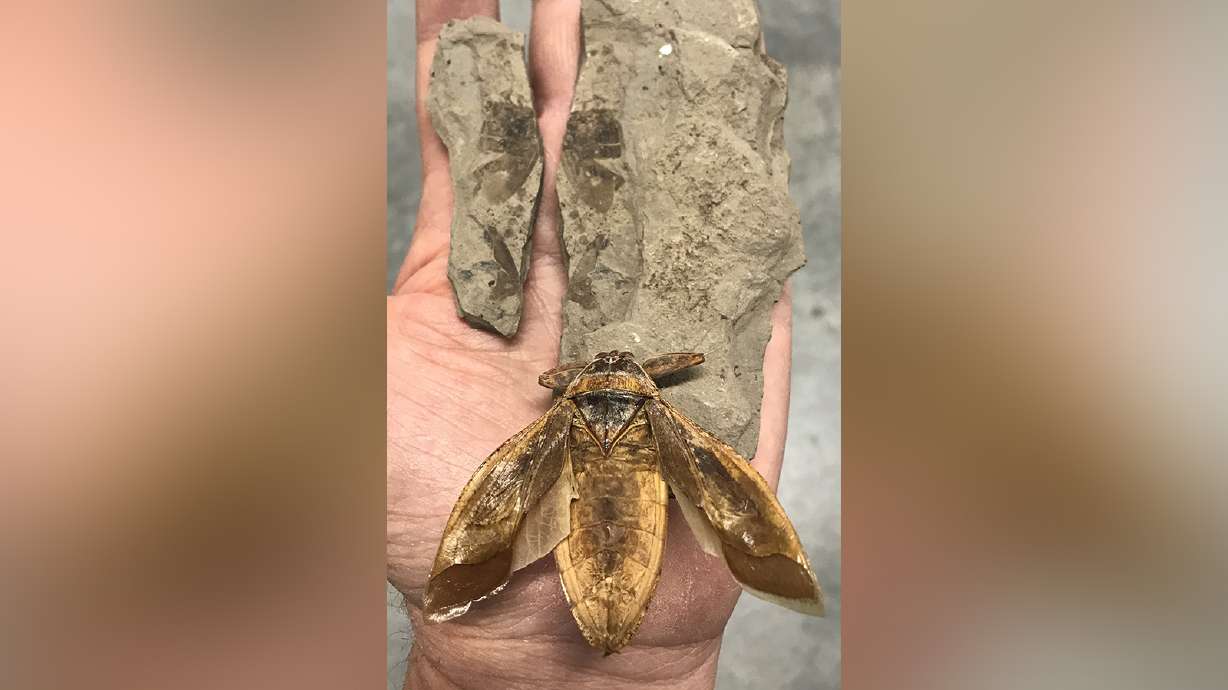Estimated read time: 3-4 minutes
This archived news story is available only for your personal, non-commercial use. Information in the story may be outdated or superseded by additional information. Reading or replaying the story in its archived form does not constitute a republication of the story.
VERNAL — Fossils across Utah have helped researchers better understand dinosaurs that roamed the planet millions of years ago, but a large bug found in eastern Utah three years ago is helping scientists better understand the insects that existed at the time, too.
The finding was reported by researchers from Argentina and Utah and published in Historical Biology on Monday. They said the insect, which paleontologists named Morrisonnepa jurassica, buzzed around 151 million years ago in the Jurassic period and appears to have been a prehistoric precursor to modern-day insects that attack and eat snails, crustaceans, fish, amphibians and snakes.
“When the animal was alive, it was several inches long,” Dr. John Foster of the Utah Field House of Natural History State Park Museum and a co-author of the study told KSL NewsRadio’s Jeff Caplan Afternoon News on Wednesday. “It looked, in the body, a little bit like a roach.”
It was discovered by paleontologists who were searching at the Late Jurassic-age Morrison Formation in southeastern Utah back in November 2017. Most of its abdomen, two parts of a forewing and what may be its head were preserved. The same expedition unearthed plant fossils in the area.
Researchers say the insect was just the second insect body fossil to be unearthed in the region. In 2011, researchers discovered what might have been a relative of crickets and grasshoppers in Colorado. The Morrisonnepa jurassica was considered to be a member of the "true water bug" insect group called Nepomorpha and related to the current Belostomatidae family, such as giant water bugs which are sometimes referred to as "toe-biters."
The discovered insect had something around its mouth that Foster likened to a “stabbing organ” likely used to impale prey. It likely fed on similar animals that its modern version does.
“We actually found parts of a salamander in the same deposit, so we know there were amphibians there that these insects may have been feeding on also,” Foster added. “By comparing with the modern ones, we can see these types of insects are essentially unchanged since the late Jurassic (period).”
María Belén Lara, a researcher from the Centro de Ecología Aplicada del Litoral in Argentina and the lead author on the study, said she thinks it’s a big finding for understanding the ecosystem in prehistoric North America.
"With this discovery, we can support that the true aquatic bugs of the Jurassic were morphologically similar to their modern counterparts," Belén said in the statement.
The discovery outlined by Lara, Foster, Dr. James Kirland of the Utah Geological Survey and Thomas Howells of the Utah Field House of Natural History State Park Museum is the second major prehistoric finding by Utah and other researchers released this year.
Researchers at the Natural History Museum of Utah, National Park Service and the Bureau of Land Management had findings of a new Allosaurus species published in the science journal PeerJ in January. The Allosaurus jimmadseni was named after further analyzing a 155 million-year-old discovered at Dinosaur National Monument in Uintah County 30 years ago.
But scientists have found plenty of more dinosaur fossils over the course of a century. The first dinosaur bones were uncovered in 1854 near the upper Missouri River, according to the University of California, Berkeley. The first dinosaur to be found in Utah was a sauropod discovered in 1859 near modern-day Moab, Utah Public Radio pointed out.
Foster explained this new discovery, along with the other recent insect discovery in Colorado, are now filling in gaps about insects that lived during the same time as the dinosaurs.
“It’s basically a whole group of insects that we previously didn’t know was a part of the ecosystem that all the dinosaurs from Dinosaur National Monument were a part of,” he said.
Researchers say they plan to return to the site sometime in the near future to search for more insect fossils.
Contributing: Jeff Caplan, KSL NewsRadio









